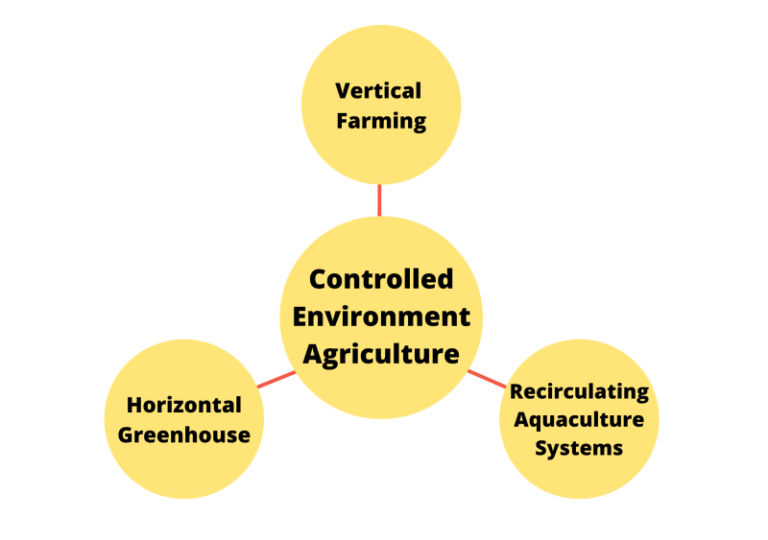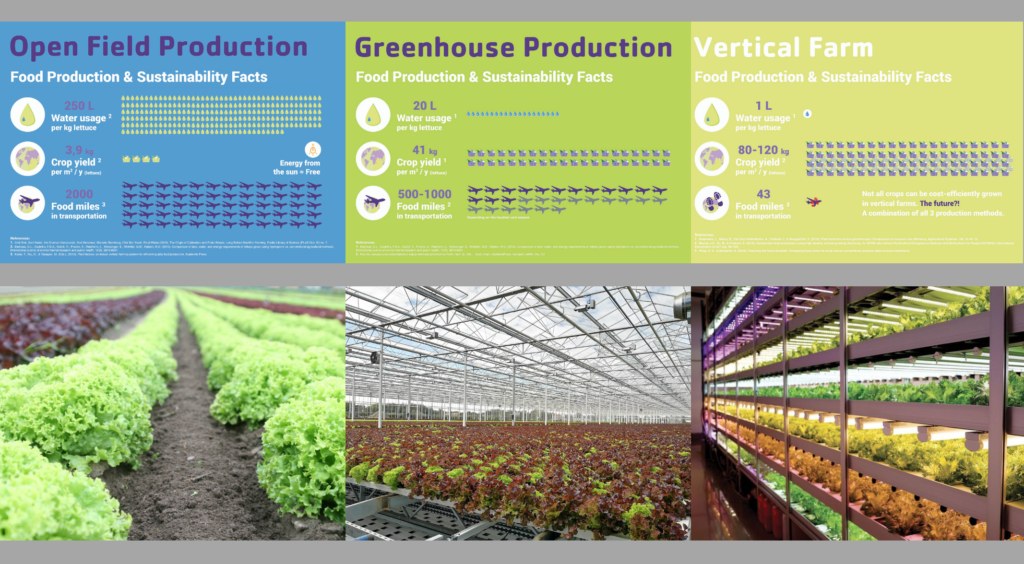Presentation of Controlled Environment Agriculture and its Potential
INTRODUCTION & TYPOLOGY
FarmTech Society (FTS) is an international non-profit industry association for the Controlled Environment Agriculture (CEA) sector, which is a practice in intensification of yields while upholding ecological principles. CEA aims to avoid adverse environmental conditions in order to optimise growth and avert threats to yield and product quality. This includes one of the following, or a combination: Greenhouses (GH) ranging from basic plastic-covered to fully enclosed high-tech glass structures; Vertical farming (VF), which is a fully enclosed insulated space with daylight-independent grow lights on multiple horizontal levels, utilising soilless growing systems (e.g. hydroponics, aeroponics). Both GH and VF grow food- and fiber-plants including also plant based inputs for cross-sectoral use (e.g. pharma), insects, mushrooms, algae, and propagation commodities; and, Recirculating Aquaculture Systems (RAS), i.e. land-based fish farming, especially aquaponics. CEA has been recognized by the European Commission as a prospecting sector constitutive of Europe’s future farming landscape (1).

CEA Advantages – Growing in a controlled-environment allows for optimizing natural processes and resource efficiency, by combining several key components that help control the process of cultivating plants and other organisms with less space, waste, water usage, along with fewer risks associated (2). This practice uses the domain of intensive agro-ecological production complementing extensive agro-ecological production such as regenerative agriculture, as well as helping with product diversification and income improvements for farmers.
- Climate adaptation & climate mitigation: Improving food safety and quality in an unfavorable, more unstable and polluted environment, by relocating growing practices into protected spaces, which removes major risks and unwanted climate influences and allows integrative circular economy applications to be rediscovered by the agriculture community. Production capacities and supply chains will be de-fossilized and implemented with smart manufacturing regimens, green infrastructure integration, and reduce long supply chain vulnerabilities as well as GHG emissions from the farming sector.
- Predictability and safety, both humans and food: CEA by design enhances food safety, based on tight sanitation and hygiene regimens inherent in the system and supply chain, whilst also implementing the critical agriculture-industry-wide need for improved waste reduction and predictable harvest planning (3). Not only does the farming technology preclude hazardous, exposed and unhealthy labor-practices, but it will also improve agriculture’s image and attractiveness by upgrading and adding technology and science profiles (STEM). Notably, CEA has openly proved its resilience potentials as a prompt local food provider for communities during the Covid-19 crisis (4).
- Circular principles showcase and supply chain stability: CEA provides a strong applied case of integration of various waste streams (nutrients, energy, efficiencies), by utilizing synergies of both existing and newly planned industrial and renewable energy infrastructure development (5 & 6) – closing nutrient cycles, balancing and buffering renewable energy production and reusing former brownfields.
CEA’S TWO-PRONGED IMPETUS
The Global Need for new Jobs, Healthy Nutrition and Food Security — Success in fulfilling the demand for healthy nutrition, without causing unintended consequences for the planet and its populations, is realistic only with a major transformation of conventional production practices for food products (2). A major part of this transformation can be achieved by adopting CEA practices in order to continue to grow more nutritious, efficient and perishable goods, while reducing land use, creating jobs under attractive STEM profiles, husband resources efficiently and even offering further improvements in the growing of commodities such as alternative proteins and functional foods. FTS and its umbrella policy strategy will directly address the current hurdles that commonly challenge all the stakeholders involved.
Rapid Technological Advancement — The speed of societal change in demands upon and within the food production industry, have polarized agricultural communities, hit hard with climate change, globalization and unattractive living wages. The (niche) solutions in CEA operations are showcases and applied examples for significant improvement on current and future challenges (7). Despite the technological complexity and regulatory hesitation to recognize CEA practices, the demand for digitalization in agriculture will also demand solutions which meet the ambitious goals put forward by regulators in terms of decarbonization, predictability and food security (1). CEA meets all these demands and can be deployed as the diversified sustainable future food system growing nutritious fruit, vegetables, fiber- and medicinal plants, alternative proteins and to some extent even large scale caloric products (8).
The current challenges caused by climate change, and expected future regulatory pressures, are forcing field farmers to transform into new practices. Considering solutions from various viable practices and innovations, CEA is a sustainable solution to critical challenges. Comparing advantages versus traditional field production, CEA offers some distinct improvements in sustainable resource management and value creation in food production. While CEA as a sustainable practice is hard to obtain for agriculture communities, due to lack of access to information and training, also prohibitively high capital costs, the agriculture sector could benefit from a partial transition into intensive ecological indoor practice.
ROLE FOR AN INDEPENDENT ASSOCIATION
FTS was founded to address the unmet needs for a robust and transparent industry association to serve as a trusted independent stakeholder in aggregating and governing sensitive data exchanges, while facilitating industry wide network opportunities and representing the interests of all industry stakeholders.

Industry Platform Purpose – Engaging industry stakeholders, from startup to SME and multinational companies, universities and vocational training institutions, regulators and planners, policy-makers, retailers, as well as grower and consumer organisations. This platform needs to be accessible and visible, providing interactive events as well as internal committees and working groups, and to partner with other industry associations and stakeholders that are of interest.

Need for Quality Information and Harmonized Typology under the Authority of an Independent Association – overcoming scattered and/or missing data through a protected database with verified information and uniform descriptions of innovation-driven systems, creating clear and concise categories, standards, certificates and criteria for the industry (9). This information is managed by FTS that provides trust and transparency in a way that enhances the industry collaborative and cross-sectoral development at a pre-competitive level.

Proactive Policy Development – Endeavoring to shape transparently the enabling environment, in terms of policy-making, regulatory as well as financial challenges and opportunities. Moving towards facilitating the integration of green infrastructures and intensive agro-ecological practices guided by circular economy principles. This cross-sectoral action spans over the whole supply chain, from fertilizers to packaging, and more, like vocational training and capacity building for STEM professional profiles.
STAKEHOLDERS
Connecting CEA solutions for critical challenges requires a cross-sectoral approach, as this important industry needs to overcome significant hurdles to achieve our societal, economic and environmental goals for a sustainable food production system. FTS unites a diverse and complex range of stakeholders under the umbrella of common goals;
- Regulators and policymakers
- Municipalities and communities
- Grower unions and cooperatives
- Consumer organizations
- All types of funding bodies
- Technology and education providers
- Academic and research institutions
- Innovators and Startups
- Subject generalists, experts and advisors
- Retail, trade- and supply chain companies
—–
REFERENCES (in order of appearance)
- Bock A.K., Krzysztofowicz M., Rudkin J. & Winthagen V., (2020) “Farmers of the Future.” EUR 30464 EN, Publications Office of the European Union.
DOI: http://dx.doi.org/10.2760/680650 - Benke K. & Tomkins B., (2017) “Future food-production systems: vertical farming and controlled-environment agriculture,” Sustainability: Science, Practice and Policy, vol. 13:1, 13-26,
DOI: https://doi.org/10.1080/15487733.2017.1394054 - United States Department of Agriculture, (2019) “Research and Development Potentials in Indoor Agriculture and Sustainable Urban Ecosystems,” Workshop Report.
URL: https://www.usda.gov/sites/default/files/documents/indoor-agriculture-workshop-report.pdf - Langemeyer J., Madrid-Lopez C., Mendoza Beltran A., & Villalba Mendez G., (2021) “Urban Agriculture — A Necessary Pathway Towards Urban Resilience and Global Sustainability,” Landscape and Urban Planning, vol. 210, 1-7.
DOI: https://doi.org/10.1016/j.landurbplan.2021.104055 - Gentry M., (2019) “Local Heat, Local Food: Integrating Vertical Hydroponic Farming with District Heating in Sweden,” Energy, vol. 174, 191-197.
DOI: https://doi.org/10.1016/j.energy.2019.02.119 - Engler N. & Krarti M., (2021) “Review of Energy Efficiency in Controlled Environment Agriculture,” Renewable and Sustainable Energy Reviews, vol. 141, 1-12.
DOI: https://doi.org/10.1016/j.rser.2021.110786 - Shoaib Farooq M., Riaz S., Abid A., Abid K., & Azhar Naeem M., (2017) “A Survey on the Role of IoT in Agriculture for the Implementation of Smart Farming,” IEEE Access, vol. 7, 156237-156271.
DOI: https://doi.org/10.1109/ACCESS.2019.2949703 - Agrilyst, “2017 State of Indoor Farming Report,” Report partnered with Cornell University & Urban Ag News.
URL: https://artemisag.com/state-of-indoor-farming-new-2017/ - Shamshiri R. R., Kalantari F., Ting K. C., Thorp K. R., Hameed I. A., Weltzien C., et al., (2018) “Advances in greenhouse automation and controlled environment agriculture: A transition to plant factories and urban agriculture,” Int J Agric & Biol Eng, vol. 11(1), 1–22.
URL: https://ijabe.org/index.php/ijabe/article/view/3210

